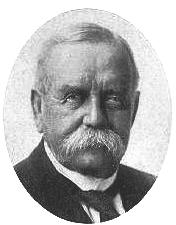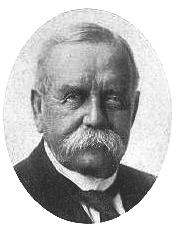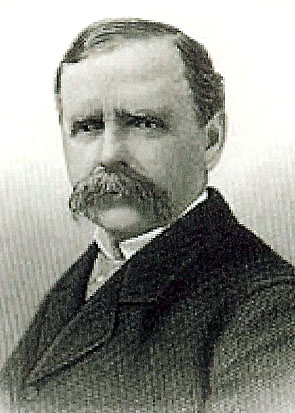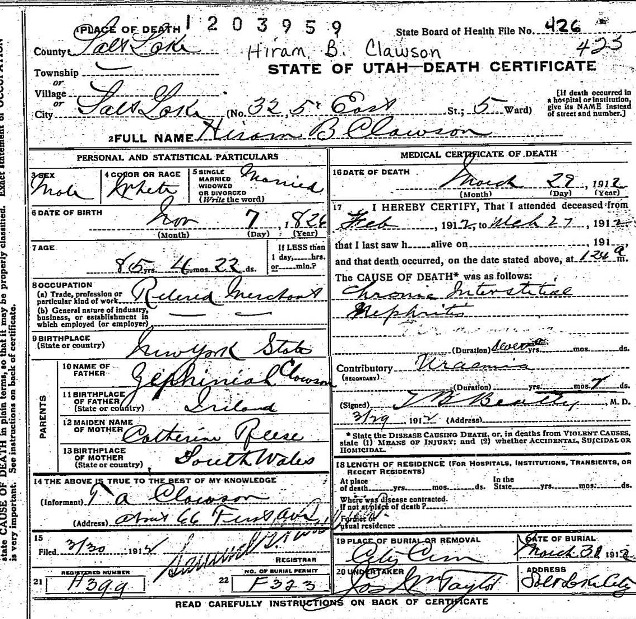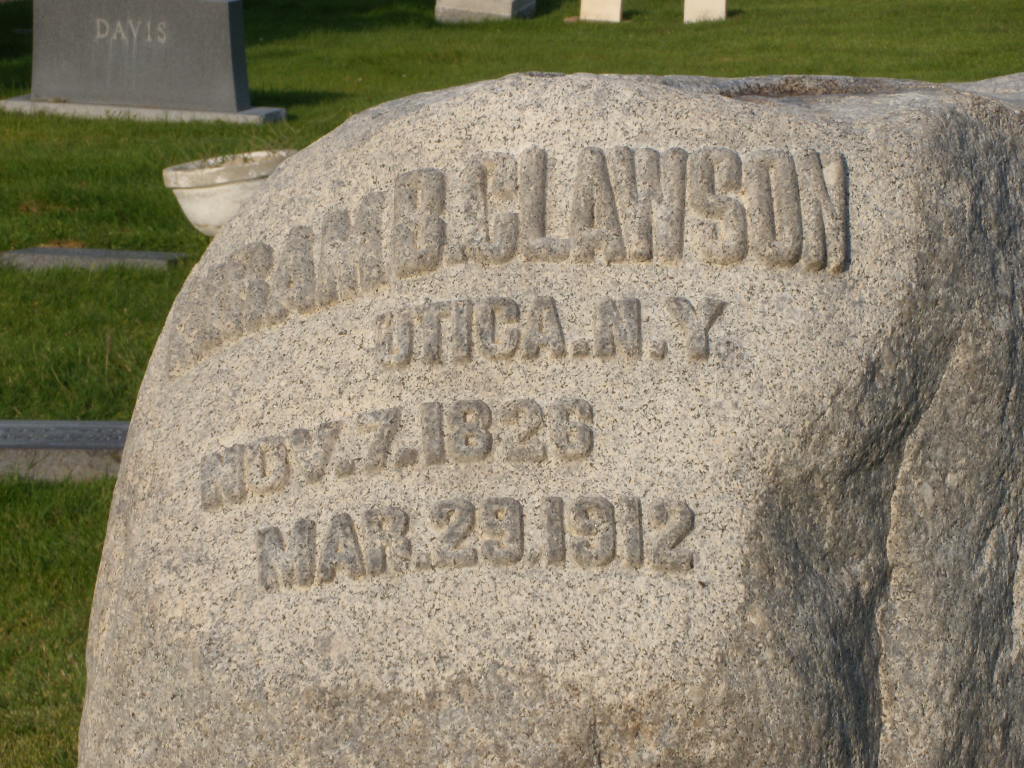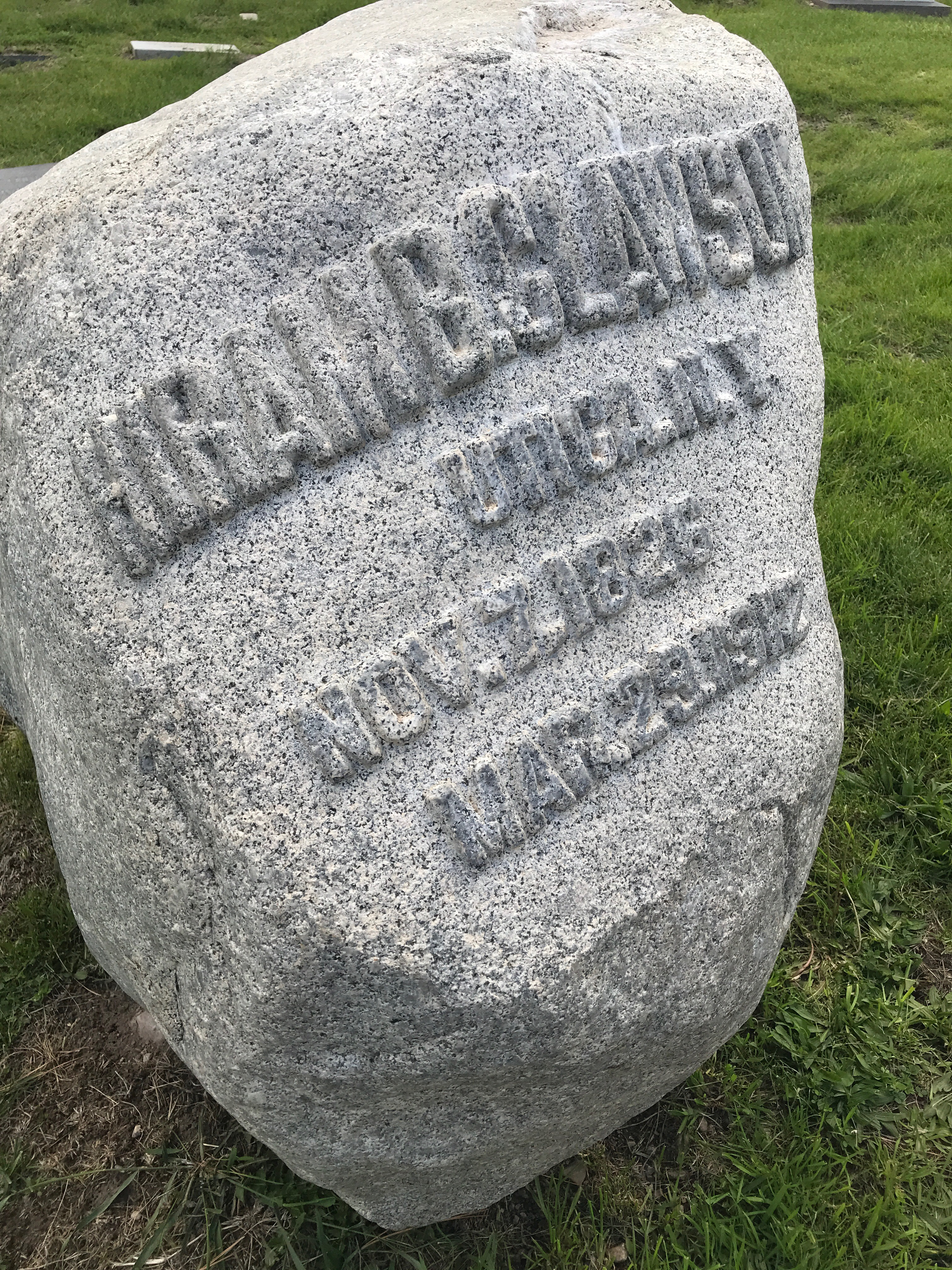Married Ellen Spencer, 18 Oct 1850, Salt Lake City, Salt Lake, Utah
Married Margaret Gay Judd, 21 Aug 1852, Salt Lake City, Salt Lake, Utah
Married Alice Young, 26 Oct 1856, Salt Lake City, Salt Lake, Utah
Married Emily Augusta Young, 4 Jan 1868, Salt Lake City, Salt Lake, Utah
Few men are better known in the Mormon community, or have been more active in the social, commercial, professional and military life of Utah than General H. B. Clawson. He is a native of Utica, Oneida county, New York, and was born November 7, 1826. What education he received, outside the hard but effectual school of practical life, was at the Utica Academy. He was but a child when his father died, and not yet in his "teens" when his widowed mother joined the Latter-day Saints. About three years later, in 1841, Mrs. Clawson and her family of two sons and two daughters migrated to Nauvoo.
It was there that young Clawson began his dramatic career, which extended over a period of many years, dating from his initial performance at Nauvoo, where the Prophet Joseph Smith fostered the drama in its purity, to the time of his retiring from the management of the Salt Lake Theatre, built and owned by President Brigham Young. Hiram Clawson was a born actor, and in the line of parts usually essayed by him—comic or character roles—displayed ability of no common order. Many of his children have inherited his dramatic talent, and have shone with lustre upon the local stage. He was a pupil of Thomas A. Lyne, a tragedian of the Edwin Forrest school, who played at Nauvoo under the patronage of the Prophet, during Mr. Clawson's residence at that place, and afterwards at Salt Lake City, under the management of his former protege.
Mr. Clawson's residence here dates from his arrival with President Brigham Young and the general immigration of 1848. In common with most of the early settlers he had to turn his hand to almost any kind of labor in order to earn a livelihood, and luckily had picked up a knowledge of several trades, which he found very useful in the building up of the new country. He had charge of the masons who erected the old Council House, and previously a little adobe office adjoining that structure on the south, the latter the first adobe building in Salt Lake valley. At one time he acted temporarily as architect of the Salt Lake Temple, during the absence of Truman O. Angell upon a mission. He was early called into President Young's office as a clerk, and was soon put in charge of his private business, which he managed for many years.
As early as 1850–51 he resumed his dramatic career, playing "Jaques Strop" to John Kay's "Robert Macaire" at the primitive theatre known as the "Old Bowery," on Temple Block. His future wife, Miss Margaret Judd, took part in the same performance, being cast for the role of "Clementina." He subsequently played at the Social Hall, which at the opening of 1853 superseded the Bowery as the main Thespian temple in these parts. In 1862, when the Salt Lake Theatre was completed, he was placed in charge of it as manager, being one of the original members of the Deseret Dramatic Association. He soon retired from the stage, but maintained his managerial connection with the Theatre, in conjunction with John T. Caine and others, for many years.
General Clawson's military record began about the year 1850. He was at the Provo Indian fight in February of that year—as related elsewhere—and subsequently became aid-de-camp to General Daniel H. Wells, the commander of the Nauvoo Legion. At the time of the disbandment of the Legion, in 1870, he had risen to the rank of adjutant-general, having succeeded General James Ferguson, deceased, in 1863. As early as 1864 he was treasurer of Salt Lake City, and was also an early member of the Territorial legislature.
For many years prior to 1865 Mr. Clawson had charge of President Young's private store, but in the spring of the year mentioned he engaged in the mercantile business on his own account, as junior partner to Horace S. Eldredge, having bought out the interest of William H. Hooper in the firm of Hooper and Eldredge. As purchaser for the new house Mr. Clawson made various trips to the East, and continued in business with General Eldredge until the firm closed out to Zion's Cooperative Mercantile Institution, organized in October, 1868. Of that mammoth concern, Mr. Clawson was the first general superintendent. He retired from the superintendency in 1873, but at the expiration of eighteen months, when his successor, Captain Hooper, resigned, he again became superintendent. It was during his second term that the institution built and moved into its large store on Main Street. On October 4, 1875, he again resigned the superintendency of Z. C. M. I., having bought out its agricultural, hide and wool departments, which he continued to own and conduct during the next ten years.
One cause of his retiring from the mercantile business was his indictment for unlawful cohabitation under the provisions of the Edmunds law. At the beginning of the anti-polygamy crusade he had four living wives and a numerous and interesting family of children. The details of his severe arraignment before Chief Justice Zane and his sentence by that magistrate to the full extent of the law—six months imprisonment and a fine of three hundred dollars and costs—are given in Chapter XV, Volume III of this history. Bishop Clawson—for he had been Bishop of the Twelfth ward for some years—could have escaped fine and imprisonment by promising to obey the law; but as this involved a repudiation of the sacred relationships he had entered into with his plural wives, he chose—to use his own words—"prison and honor" rather than "liberty and dishonor."
The names of his wives were Ellen Spencer Clawson, Margaret Judd Clawson, Alice Young Clawson and Emily Young Clawson; the first a daughter of Hon. Orson Spencer, the second the Miss Judd previously mentioned, and the other two daughters of President Brigham Young. All were living at this time excepting Mrs. Alice Clawson.
After his emergence from the penitentiary—where, as usual with such cases, the term of his sentence was materially shortened by good behavior—Bishop Clawson took an active part in bringing about the changed conditions which have resulted in the amicable adjustment of local troubles and the giving of Statehood to Utah. For the purpose of using influence to that end he went East repeatedly, visiting Washington, D.C., in company with President George Q. Cannon, Colonel Isaac Trumbo and others, and the fact that peace now reigns in Utah is due in no small degree to their energetic efforts to secure the precious boon for themselves and their fellow citizens. Specially commissioned by the Church authorities, Bishop Clawson also visited Arizona, at the outbreak of the crusade, and through the good offices of Governor Zulick of that Territory, succeeded in establishing relations favorable to his people, which have ever since been respected and adhered to by the officials of that commonwealth.
Of late years Mr. Clawson has been engaged in mining. Aside from this he is no longer in business, though he looks after his vested interests with his old time sagacity. In his seventy-seventh year, he is hale and hearty, is still Bishop of the Twelfth ward, and active in the performance of his duties. He is the father, by his first wife, of Hon. Spencer Clawson, a well known business man, ex-chairman of the Utah Pioneer Jubilee Commission; by his second wife, of Rudger Clawson, the Apostle; and by his third wife, Alice, of J. Willard Clawson, the artist. He has other sons and daughters, both prominent and talented, but the members of his household are too numerous to be mentioned, all, in a sketch of this character.
Orson F. Whitney, History of Utah, Vol. 4, p. 201-203
Married Ellen Spencer, 18 Oct 1850, Salt Lake City, Salt Lake, Utah
Married Margaret Gay Judd, 21 Aug 1852, Salt Lake City, Salt Lake, Utah
Married Alice Young, 26 Oct 1856, Salt Lake City, Salt Lake, Utah
Married Emily Augusta Young, 4 Jan 1868, Salt Lake City, Salt Lake, Utah
Few men are better known in the Mormon community, or have been more active in the social, commercial, professional and military life of Utah than General H. B. Clawson. He is a native of Utica, Oneida county, New York, and was born November 7, 1826. What education he received, outside the hard but effectual school of practical life, was at the Utica Academy. He was but a child when his father died, and not yet in his "teens" when his widowed mother joined the Latter-day Saints. About three years later, in 1841, Mrs. Clawson and her family of two sons and two daughters migrated to Nauvoo.
It was there that young Clawson began his dramatic career, which extended over a period of many years, dating from his initial performance at Nauvoo, where the Prophet Joseph Smith fostered the drama in its purity, to the time of his retiring from the management of the Salt Lake Theatre, built and owned by President Brigham Young. Hiram Clawson was a born actor, and in the line of parts usually essayed by him—comic or character roles—displayed ability of no common order. Many of his children have inherited his dramatic talent, and have shone with lustre upon the local stage. He was a pupil of Thomas A. Lyne, a tragedian of the Edwin Forrest school, who played at Nauvoo under the patronage of the Prophet, during Mr. Clawson's residence at that place, and afterwards at Salt Lake City, under the management of his former protege.
Mr. Clawson's residence here dates from his arrival with President Brigham Young and the general immigration of 1848. In common with most of the early settlers he had to turn his hand to almost any kind of labor in order to earn a livelihood, and luckily had picked up a knowledge of several trades, which he found very useful in the building up of the new country. He had charge of the masons who erected the old Council House, and previously a little adobe office adjoining that structure on the south, the latter the first adobe building in Salt Lake valley. At one time he acted temporarily as architect of the Salt Lake Temple, during the absence of Truman O. Angell upon a mission. He was early called into President Young's office as a clerk, and was soon put in charge of his private business, which he managed for many years.
As early as 1850–51 he resumed his dramatic career, playing "Jaques Strop" to John Kay's "Robert Macaire" at the primitive theatre known as the "Old Bowery," on Temple Block. His future wife, Miss Margaret Judd, took part in the same performance, being cast for the role of "Clementina." He subsequently played at the Social Hall, which at the opening of 1853 superseded the Bowery as the main Thespian temple in these parts. In 1862, when the Salt Lake Theatre was completed, he was placed in charge of it as manager, being one of the original members of the Deseret Dramatic Association. He soon retired from the stage, but maintained his managerial connection with the Theatre, in conjunction with John T. Caine and others, for many years.
General Clawson's military record began about the year 1850. He was at the Provo Indian fight in February of that year—as related elsewhere—and subsequently became aid-de-camp to General Daniel H. Wells, the commander of the Nauvoo Legion. At the time of the disbandment of the Legion, in 1870, he had risen to the rank of adjutant-general, having succeeded General James Ferguson, deceased, in 1863. As early as 1864 he was treasurer of Salt Lake City, and was also an early member of the Territorial legislature.
For many years prior to 1865 Mr. Clawson had charge of President Young's private store, but in the spring of the year mentioned he engaged in the mercantile business on his own account, as junior partner to Horace S. Eldredge, having bought out the interest of William H. Hooper in the firm of Hooper and Eldredge. As purchaser for the new house Mr. Clawson made various trips to the East, and continued in business with General Eldredge until the firm closed out to Zion's Cooperative Mercantile Institution, organized in October, 1868. Of that mammoth concern, Mr. Clawson was the first general superintendent. He retired from the superintendency in 1873, but at the expiration of eighteen months, when his successor, Captain Hooper, resigned, he again became superintendent. It was during his second term that the institution built and moved into its large store on Main Street. On October 4, 1875, he again resigned the superintendency of Z. C. M. I., having bought out its agricultural, hide and wool departments, which he continued to own and conduct during the next ten years.
One cause of his retiring from the mercantile business was his indictment for unlawful cohabitation under the provisions of the Edmunds law. At the beginning of the anti-polygamy crusade he had four living wives and a numerous and interesting family of children. The details of his severe arraignment before Chief Justice Zane and his sentence by that magistrate to the full extent of the law—six months imprisonment and a fine of three hundred dollars and costs—are given in Chapter XV, Volume III of this history. Bishop Clawson—for he had been Bishop of the Twelfth ward for some years—could have escaped fine and imprisonment by promising to obey the law; but as this involved a repudiation of the sacred relationships he had entered into with his plural wives, he chose—to use his own words—"prison and honor" rather than "liberty and dishonor."
The names of his wives were Ellen Spencer Clawson, Margaret Judd Clawson, Alice Young Clawson and Emily Young Clawson; the first a daughter of Hon. Orson Spencer, the second the Miss Judd previously mentioned, and the other two daughters of President Brigham Young. All were living at this time excepting Mrs. Alice Clawson.
After his emergence from the penitentiary—where, as usual with such cases, the term of his sentence was materially shortened by good behavior—Bishop Clawson took an active part in bringing about the changed conditions which have resulted in the amicable adjustment of local troubles and the giving of Statehood to Utah. For the purpose of using influence to that end he went East repeatedly, visiting Washington, D.C., in company with President George Q. Cannon, Colonel Isaac Trumbo and others, and the fact that peace now reigns in Utah is due in no small degree to their energetic efforts to secure the precious boon for themselves and their fellow citizens. Specially commissioned by the Church authorities, Bishop Clawson also visited Arizona, at the outbreak of the crusade, and through the good offices of Governor Zulick of that Territory, succeeded in establishing relations favorable to his people, which have ever since been respected and adhered to by the officials of that commonwealth.
Of late years Mr. Clawson has been engaged in mining. Aside from this he is no longer in business, though he looks after his vested interests with his old time sagacity. In his seventy-seventh year, he is hale and hearty, is still Bishop of the Twelfth ward, and active in the performance of his duties. He is the father, by his first wife, of Hon. Spencer Clawson, a well known business man, ex-chairman of the Utah Pioneer Jubilee Commission; by his second wife, of Rudger Clawson, the Apostle; and by his third wife, Alice, of J. Willard Clawson, the artist. He has other sons and daughters, both prominent and talented, but the members of his household are too numerous to be mentioned, all, in a sketch of this character.
Orson F. Whitney, History of Utah, Vol. 4, p. 201-203
Family Members
-
![]()
Hiram Bradley Clawson Jr
1851–1914
-
![]()
Orson Spencer Clawson
1852–1916
-
Catherine Chole Clawson
1854–1854
-
![]()
Stanley Hastings Clawson
1854–1933
-
![]()
Teresa Clawson Wells
1855–1897
-
![]()
Edna Ellen Clawson Tibbitts
1855–1945
-
Laura Aurelia Clawson
1857–1859
-
![]()
Rudger Clawson
1857–1943
-
![]()
Lucy Ardella Clawson Cummings
1858–1934
-
![]()
John Willard Clawson
1858–1936
-
![]()
Leo Herbert Clawson
1859–1937
-
![]()
Sidney Beatie Clawson
1860–1936
-
![]()
Georgia Clawson Foote
1860–1944
-
![]()
Walter Scott Clawson
1861–1906
-
![]()
Edith Helen Spencer Clawson Knowlton
1862–1940
-
![]()
Thomas Alfred Clawson Sr
1862–1942
-
![]()
Phebe Kimball Clawson Taylor
1862–1948
-
![]()
Selden Irwin Clawson
1863–1958
-
Florence Harriet Clawson
1864–1865
-
Howard Wells Clawson
1866–1867
-
![]()
Luna Clawson
1866–1867
-
Mabel Clawson
1867–1870
-
![]()
Mary "Mamie" Clawson Beatie
1867–1936
-
![]()
Harry Clawson
1868–1869
-
![]()
Ivie Clawson Greene
1868–1956
-
![]()
Louine Carlie Clawson Young
1869–1965
-
Infant Clawson
1870–1870
-
![]()
Victor Young Clawson
1870–1871
-
![]()
Winifred Clawson Ellerbeck
1870–1942
-
![]()
Monroe Clawson
1872–1873
-
![]()
Nell Young Clawson Rosenbaum
1872–1937
-
![]()
Tessie Clawson Groesbeck
1872–1963
-
Roy Clawson
1873–1878
-
Gay Clawson
1874–1879
-
![]()
Kate Young Clawson Lambert
1874–1914
-
![]()
Alice Clawson Campbell
1876–1956
-
![]()
Ruby Clawson Godbe
1876–1973
-
![]()
Bessie Young Clawson Hughes
1878–1942
-
![]()
Shirl Young Clawson
1881–1929
-
![]()
Chester Young Clawson
1883–1962
-
![]()
Josephine Clawson Thomson
1886–1975
-
![]()
Scott Richmond Clawson
1888–1906
Sponsored by Ancestry
Advertisement
Explore more
Sponsored by Ancestry
Advertisement
